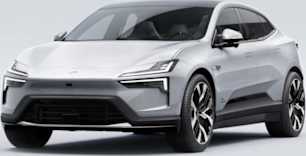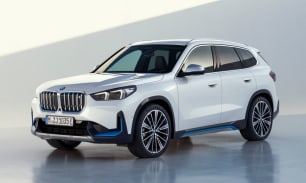Sliding into the driver’s seat, the first thing I notice is how high the centre console sits. This is clearly a Polestar thing because it’s similar to the 2. This adds to the sporty feel of the cabin, but I don’t know if it needs to be that high.
It does however liberate a massive amount of storage space under the console. You could fit a handbag, shoes or other items there, and Polestar offers accessories like bicycle-esque bottle holders.
There’s more storage in the smallish central bin which also houses two USB-C ports, a half-hidden phone charging pad, and door bins that will fit a larger bottle, but only lying down.
The seats are comfortable and the cloth-like sustainable material in the Singe Motor grade looks great, but it can grip on to clothes a little. The perforated Zinc-coloured ‘animal welfare’ Nappa leather in the Dual Motor is stunning and probably what I would opt for. Which is rare given I am no leather fan. But whatever the material, there’s a decent amount of support on offer.
If you opt for the Nappa upgrade ($7000) you get Harman Kardon speakers embedded in the front headrests. It’s an interesting addition but it sounds quite cool when you realise where the sound is coming from.
Aside from the ‘play’ dial on the console, there are very few visible buttons. Meaning every function is housed in the central 15.4-inch landscape digital display.
I recently spent some time in another new Geely Group product - the Volvo EX30 - which has a similar set-up.
Thankfully, the menu is easy to navigate and the main screen is split between nav (running Google Maps of course) and up to four other functions, including apps like Spotify, a quick link to often-used controls and whatever else you want to customise.
Aside from the visually appealing graphics and colours, the display is crisp and easy to get your head around. The air con is easy to access and you use the screen to change the direction of the vents, which oscillate on the passenger side.
The ambient lighting which is solar system themed is pretty cool, too. You pick the colour by planet. And the ‘Hey Google’ command appears to work well.
However, functions like opening the glove box should still be a physical button. There is no reason it needs to be housed in the screen. Also, adjusting the exterior mirrors and steering wheel required a lesson from the Polestar team. You can do it via the screen, or by using the smart controls on the steering wheel that change depending on what function you need.
Again, this is very clever tech, but is it that necessary? Just because Tesla does something, doesn’t mean every other EV brand on the planet needs to follow suit.
Then we get to the digital interior rearview mirror. While the lack of a rear windscreen does not impact the look of the car negatively, it’s another element that feels like tech for tech’s sake. Is there really enough of a benefit to interior space to justify this radical change to the car?
The display is clear but when you look at it then the exterior mirrors, the object in the display seems closer than the mirrors. There’s also no washer for the camera, with Polestar suggesting the angle means it doesn’t need one. The question remains, what happens if it malfunctions?
I realise you can’t see out the back of plenty of vehicles, like trucks and, often, delivery vans. It’s also something you have to navigate when you pack your car full of gear for holiday and can’t see past all the luggage. And I appreciate many more people will be drawn in by the tech of it all. But for me it remains the answer to a question no one asked.
Moving to the rear, the slightly bucketed seats are plush and supportive and there is acres of legroom thanks to the Polestar 4’s 4.8-metre wheelbase. It is a spacious cabin no doubt, but the placement of the battery pack under the floor means your knees sit up higher than they would in an ICE car. It’s a similar phenomenon in Tesla models. There’s also no toe room under the front seats.
You can, however, recline the rear seats slightly, making for a more relaxed vibe back there. There are amenities like rear digital climate controls, more USB-C ports, chest and knee-level air vents, and a fold-down arm-rest with cupholders, but big bottles won’t fit in the doors.
The boot appears shallow but there is under-floor storage where you can house the charging cable as well as flatter items. All up you get up to 526 litres of cargo space (that includes 31L under-floor), increasing to 1536L with the 60/40 split rear seats folded, while a front cargo space swallows 15L.
Polestar only offers a tyre repair kit for the 4, so no temporary spare.























.png)







.png)


.png)

.png)

.png)


.png)

.png)

.png)
.png)
.png)



.png)


.png)





.png)













































.png)
.png)













.png)

































.png)











.png)

.png)


.png)












.png)


.png)








